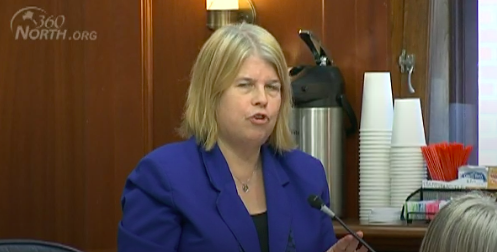WHERE THEY DON’T BARRICADE THEMSELVES IN
By ART CHANCE
SENIOR CONTRIBUTOR
I went to Utah to chase trains. May 10 was the 150th anniversary of the driving of the Golden Spike that marked the completion of the Transcontinental Railroad in 1869, six years after Abraham Lincoln signed the enabling legislation in the middle of America’s Civil War.
Like Alaska, much of Utah is occupied by the federal government, but unlike Alaska, large swathes of it are highly developed. Railroads and natural resources/agriculture drove Utah’s development. Because of the Transcontinental Railroad, known at its genesis as the Pacific Railroad, the primary means of commerce between the East and the West was the driver of the Utah economy.
Railroads in the 19th and early 20th centuries were enormously needy. One of the greatest, perhaps the greatest, drivers of the US economy in the late 19th and early 20th centuries was supplying the needs of the railroads.
The original right of way of the Transcontinental Railway was a very slap-dash endeavor; government funding is pretty much a guarantee of corruption and the Pacific Railroad provides a textbook in corruption. You had a mix of dedicated railroad men who really wanted to build a railroad to connect the Atlantic and Pacific and financiers who wanted to reach their hands as far into the federal treasury as possible. Once built, the Transcontinental Railroad was mired in scandal and corruption for the remainder of the 19th century and ultimately went to the auction block in bankruptcy. Only in the early 20th century under the Harriman management scheme was any legitimacy restored to the operation and ultimately the Union Pacific became one of America’s foremost industrial concerns, and remains so today.
Despite the entreaties of the Mormon Church, the Union Pacific did not go to Salt Lake City, the largest community in Utah at the time. Railroads hate hills and many scouts and surveyors scoured the hills and hollows of Utah to find “water level” routes over the Wasatch Range of mountains. Ogden, Utah became a center of UP endeavor in Utah, a few miles north of Salt Lake City. A major railroad center had even more impact on a town or city in the 19th century than an international airport does today. Salt Lake City ultimately attracted the Rio Grande Railroad and a link to the UP at Ogden and became a major railroad center in its own right.
Today, Salt Lake City and the interstate corridor to Ogden is a fascinating juxtaposition of old and new. Unlike most of America, the area has not torn down its legacy architecture and replaced it with modern brutal and ugly. The lovely pre-WWII industrial era architecture survives. Beautiful old buildings have been repurposed and modernized to today’s usages but have retained their character. If you find comfort in the urban scenery of “Miracle on 34th Street,” you can still find that scenery in Salt Lake City. If you like the smaller city urban landscape of “It’s a Wonderful Life,” you can find it in Ogden, even though most of it is in what was once the bar and whorehouse district on the wrong side of the tracks near the railroad station, 25th Street, locally and affectionately known as “Two bit Street”.
Ogden was to Salt Lake City as McCarthy was to Kennicott; all the things you couldn’t get in one, you could get in the other.
Today’s Salt Lake City is the classic Western Cartesian grid. Somewhere along the way, political correctness has changed the names of lots of streets and avenues to numbers; the Left strives mightily to erase US History. Utah rallies back by still putting the old name in smaller letters beneath the numbers.
The Utah Capitol Building, in fitting Roman architecture, sits impressively on a hill overlooking the city, and overlooking the Mormon Church edifices. The conflicts between the LDS and the US are not a well-known part of US History, but the relationship was less than friendly through the 1850s and ‘60s. The Saints made some serious concessions to Caesar to become a part of the Union, including making an explicit repudiation of polygamy in order to have their Constitution accepted.
Author Harry Turtledove in his “How Few Remain” alternative history series takes a very interesting look at what a flirtation between Utah’s Mormons and the Confederate States might have looked like. There is still bad blood between the Mormon Church and the Union Pacific Railroad over some Mormon tracklayers not getting paid during the building of the Transcontinental Railroad.
Salt Lake City is the cleanest and neatest US city I have ever seen; there is no trash. The streets and avenues are wide and most have tree-lined medians. They have a program of encouraging pedestrians to take orange flags from baskets at every crosswalk and wave them as they cross the street. I never did, but if you walk with the sedentary shuffle of advancing age, you’ll see the 00 on the light before you get across the street; I guess they expect all pedestrians to be fit.
In a week there, I saw one panhandler. I don’t know if he was homeless since he looked pretty prosperous and was lazily panhandling from an island in the street between a Whole Foods and a Sundance Outlet Store; that is hunting in a baited field.
The closest I saw to disorderly conduct was a group of millennials on city-provided scooters blasting down the sidewalks, but even they usually said excuse me as they passed by. We came in late one night and there were some screeching tires and loud mufflers on the after-midnight streets, but that was kind of refreshing; the last time adults cared about that was the 1950s.
One of the things I liked most about Alaska when I came here in the 1970s was that nobody cared what you did so long as you didn’t do it to them or expect them to do it. Alaska’s essential lawlessness was acceptable when we had an essentially lawful populus. We had some rough parts of town, and we all knew what a “Spenard Divorce” was. But unless you were doing bad things, it was unlikely a bad thing was going to happen to you.
Today, we have gunfights on the streets.We have roving gangs of thieves scouring cars and garages in neighborhoods all over town. I live in what most would consider a “good” neighborhood, but I am compelled to have motion detector lights, game cameras, and a readily accessible firearm.
We shouldn’t have to live like this. I want to live in a clean, well-lighted place again.
Art Chance is a retired Director of Labor Relations for the State of Alaska, formerly of Juneau and now living in Anchorage. He is the author of the book, “Red on Blue, Establishing a Republican Governance,” available at Amazon. Photo by Garret, Flickr.








